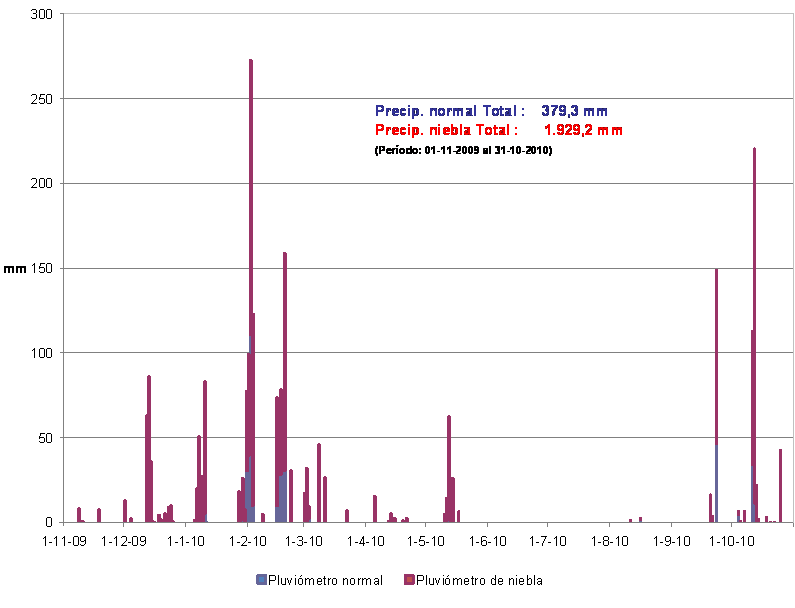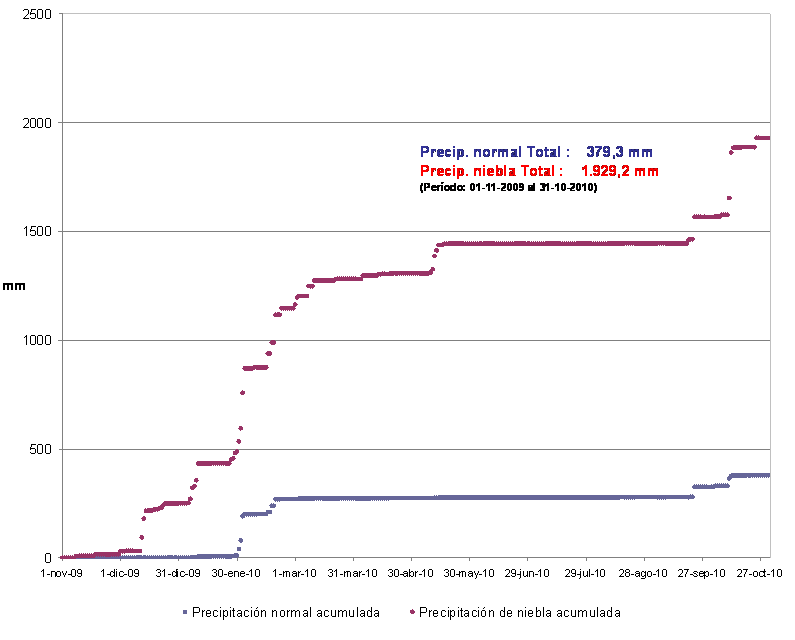Development of a pluviometer to measure water content of mist
The area around the Izaña Atmospheric Research Center (IZO) mostly enjoys clear skies, so rainfall is reduced to a few days a year – 43.4 days to be precise, leaving a total of 461.5 mm of rain water. (Data referring to the period 1970-1999, extracted from “Climatología del Parque Nacional de las Cañadas del Teide”, Bustos et al, 2000).
However, another important source of water is the ‘hidden precipitation’ caused by mist, which is common in those areas exposed to the trade winds and at certain altitude, where water vapor condenses to form the typical ‘sea of clouds’. Mush of the vegetation in these parts survives thanks to the extra water provided by the collection of water droplets from the mist.
Given the importance this source of water, the decision was taken to install a pluviometer in the meteorological station at the Izaña Atmospheric Research Observatory to objectively measure the amount of rain water collected from mist. To do this, two Hellman pluviometers (one manual and the other an automatic tipping bucket system) were fitted with a cylindrical metal mesh 10 cm in diameter by 22 cm in length and a 0.2 cm x 0.2 cm weave, in accordance with the directives of the WMO technical note “Guide to Meteorological Instruments and Methods of Observation”.
Figure 1: The two pluviometers installed at the Izaña Atmospheric Research Center to measure precipitation from mist. Left, in the foreground, the automatic pluviometer and in the background, the manual gauge. Right, in the foreground, the manual pluviometer adapted for mist with the mesh and the normal gauge in the background.
The data obtained during the first year after the installation of the pluviometers is very interesting – precipitation collected by the normal pluviometer from November 1 2009 to October 31 2010 was 379.3 mm. The pluviometer for mist collected 1929.2 mm in the same period. If the rainfall collected by the standard gauge is subtracted from this, what remains is the hidden precipitation or horizontal rainfall, totaling 1549.9 mm, a value multiplying by four that for conventional rainfall.
Although the number of misty days recorded is higher than double the number of days with precipitation in the form of rain (77 compared to 36), it should be pointed out that around Izaña the episodes more or less coincide in time, so that the highest recordings of rainfall from mist are obtained during the rainy season, quite the opposite to what happens in other parts of the island of Tenerife, such as the Anaga massif, where the highest recordings are made in summer. (Marzol et al, El potencial hídrico de los Stratocumulus subtropicales. El caso de Canarias y Marruecos). The difference may be caused by the fact that it is precisely in summer when the trade winds blow strongest and the Stratocumulus, which cause mist, usually cover the peaks of Anaga. Izaña, however, is above the Stratocumulus layer being at a higher altitude and, as a result, there are not usually mist episodes during summer.

Graph 1: Daily precipitation recorded by the standard pluviometer (blue bars) compared with the mist pluviometer (red bars) during the study period.

Graph 2: Accumulated precipitation with the standard pluviometer (blue dots) compared with the mist pluviometer (red dots) during the study period.







